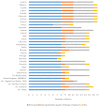Developing and testing a protocol using a common data model for federated collection and analysis of national perinatal health indicators in Europe
- PMID: 37830050
- PMCID: PMC10565425
- DOI: 10.12688/openreseurope.15701.2
Developing and testing a protocol using a common data model for federated collection and analysis of national perinatal health indicators in Europe
Abstract
Context: International comparisons of the health of mothers and babies provide essential benchmarks for guiding health practice and policy, but statistics are not routinely compiled in a comparable way. These data are especially critical during health emergencies, such as the coronavirus disease (COVID-19) pandemic. The Population Health Information Research Infrastructure (PHIRI) project aimed to promote the exchange of population data in Europe and included a Use Case on perinatal health. Objective: To develop and test a protocol for federated analysis of population birth data in Europe. Methods: The Euro-Peristat network with participants from 31 countries developed a Common Data Model (CDM) and R scripts to exchange and analyse aggregated data on perinatal indicators. Building on recommended Euro-Peristat indicators, complemented by a three-round consensus process, the network specified variables for a CDM and common outputs. The protocol was tested using routine birth data for 2015 to 2020; a survey was conducted assessing data provider experiences and opinions. Results: The CDM included 17 core data items for the testing phase and 18 for a future expanded phase. 28 countries and the four UK nations created individual person-level databases and ran R scripts to produce anonymous aggregate tables. Seven had all core items, 17 had 13-16, while eight had ≤12. Limitations were not having all items in the same database, required for this protocol. Infant death and mode of birth were most frequently missing. Countries took from under a day to several weeks to set up the CDM, after which the protocol was easy and quick to use. Conclusion: This open-source protocol enables rapid production and analysis of perinatal indicators and constitutes a roadmap for a sustainable European information system. It also provides minimum standards for improving national data systems and can be used in other countries to facilitate comparison of perinatal indicators.
Keywords: Birth data; caesarean delivery; federated analysis; maternal; national statistics; newborn; perinatal; population health indicators.
Copyright: © 2023 Zeitlin J et al.
Conflict of interest statement
No competing interests were disclosed.
Figures


References
LinkOut - more resources
Full Text Sources
Miscellaneous
